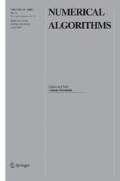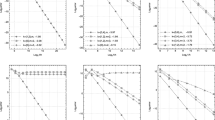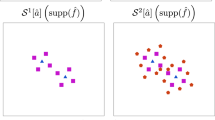Abstract
This work investigates finite differences and the use of (diagonal) quadratic interpolation models to obtain approximations to the first and (non-mixed) second derivatives of a function. Here, it is shown that if a particular set of points is used in the interpolation model, then the solution to the associated linear system (i.e., approximations to the gradient and diagonal of the Hessian) can be obtained in \(\mathcal {O}(n)\) computations, which is the same cost as finite differences, and is a saving over the \(\mathcal {O}(n^{3})\) cost when solving a general unstructured linear system. Moreover, if the interpolation points are chosen in a particular way, then the gradient approximation is \(\mathcal {O}(h^{2})\) accurate, where h is related to the distance between the interpolation points. Numerical examples confirm the theoretical results.



Similar content being viewed by others
Notes
The work in [18] appeared after this work.
Note that α and γ are functions of n, but for notational simplicity we avoid explicitly writing the dependence on n.
Note that μ and ω are functions of n, but for notational simplicity we avoid explicitly writing the dependence on n.
References
Audet, C., Hare, W.: Derivative-free and blackbox optimization. Springer Series in Operations Research and Financial Engineering, Springer (2017)
Bandeira, A.S., Scheinberg, K., Vicente, L.N.: Computation of sparse low degree interpolating polynomials and their application to derivative-free optimization. Mathematical Programming Series B 134, 223–257 (2012)
Baydin, A.G., Pearlmutter, B.A., Radul, A.A., Siskind, J.M.: Automatic differentiation in machine learning: a survey. J. Mach. Learn. Res. 18, 1–43 (2018). Editor: Léon Bottou
Berahas, A.S., Cao, L., Choromanskiy, K., Scheinberg, K.: A theoretical and empirical comparison of gradient approximations in derivative-free optimization. Tech. rep., Department of Industrial and Systems Engineering, Lehigh University, Bethlehem, PA, USA. arXiv:1905.01332v2 [math.OC] (2019)
Cocchi, G., Liuzzi, G., Papini, A., Sciandrone, M.: An implicit filtering algorithm for derivative-free multiobjective optimization with box constraints. Comput. Optim. Appl. 69(2), 267–296 (2018)
Conn, A., Scheinberg, K., Vicente, L.: Introduction to Derivative-Free Optimization. MPS-SIAM Series on Optimization, Philadelphia (2009)
Conn, A., Scheinberg, K., Toint, P.: Recent progress in unconstrained nonlinear optimization without derivatives. Math. Program. 79, 397–414 (1997)
Conn, A.R., Scheinberg, K., Vicente, L.N.: Geometry of interpolation sets in derivative free optimization. Mathematical Programming Series B 111, 141–172 (2008)
Conn, A.R., Scheinberg, K., Vicente, L.N.: Geometry of sample sets in derivative-free optimization: polynomial regression and underdetermined interpolation. IMA J. Numer. Anal. 28, 721–748 (2008)
Conn, A.R., Toint, P.L.: An algorithm using quadratic interpolation for unconstrained derivative free optimization. In: Di Pillo, G., Giannessi, F. (eds.) Nonlinear Optimization and Applications, pp. 27–47. Springer US, Boston, MA (1996)
Coope, I., Price, C.: Frame-based methods for unconstrained optimization. J. Optim. Theory Appl. 107(2), 261–274 (2000)
Coope, I.D., Tappenden, R.: Efficient calculation of regular simplex gradients. Comput. Optim. Appl. 72(3), 561–588 (2019). https://doi.org/10.1007/s10589-019-00063-3
Fasano, G., Morales, J.L., Nocedal, J.: On the geometry phase in model-based algorithms for derivative-free optimization. Optimization Methods and Software 24(1), 145–154 (2009)
Fazel, M., Ge, R., Kakade, S., Mesbahi, M.: Global convergence of policy gradient methods for the linear quadratic regulator. Proc. Mach. Learn. Res. (PMLR) 80, 1467–1476 (2018). International Conference on Machine Learning, 10–15, July 2018, Stockholmsmässan, Stockholm, Sweden
Gilmore, P., Kelley, C.: An implicit filtering algorithm for optimization of functions with many local minima. SIAM J. Optim. 5(2), 269–285 (1995)
Gilmore, P., Kelley, C.T., Miller, C.T., Williams, G.A.: Implicit filtering and optimal design problems. In: Borggaard, J., Burkardt, J., Gunzburger, M., Peterson, J. (eds.) Optimal Design and Control, pp. 159–176. Birkhäuser, Boston (1995)
Hare, W., Jaberipour, M.: Adaptive interpolation strategies in derivative-free optimization: a case study. Tech. Rep., University of British Colombia, Canada, and Amirkabir University of Technology, Iran. arXiv:1511.02794v1 [math.OC] (2015)
Hare, W., Jarry-Bolduc, G., Planiden, C.: Error bounds for overdetermined and underdetermined generalized centred simplex gradients. Tech. Rep., University of British Colombia, Canada, and University of Wollongong, Australia. arXiv:2006.00742v1 [math.NA] (2020)
Hoffmann, P.H.W.: A hitchhiker’s guide to automatic differentiation. Numerical Algorithms 72(3), 775–811 (2016). https://doi.org/10.1007/s11075-015-0067-6
Jarry-Bolduc, G., Nadeau, P., Singh, S.: Uniform simplex of an arbitrary orientation. Optim. Lett. Published online 03, July 2019, https://doi.org/10.1007/s11590-019-01448-3 (2019)
Maggiar, A., Wächter, A., Dolinskaya, I.S., Staum, J.: A derivative-free trust-region algorithm for the optimization of functions smoothed via gaussian convolution using adaptive multiple importance sampling. SIAM J. Optim. 28(2), 1478–1507 (2018)
Margossian, C.C.: A review of automatic differentiation and its efficient implementation. Tech. Rep., Department of Statistics, Columbia University. arXiv:1811.05031v2 [cs.MS] (2019)
Nelder, J., Mead, R.: A simplex method for function minimization. Comput. J. 7(4), 308–313 (1965)
Nesterov, Y., Spokoiny, V.: Random gradient-free minimization of convex functions. Found. Comput. Math. 17(2), 527–566 (2017)
Nocedal, J., Wright, S.J.: Numerical Optimization, 2 ed. Springer Series in Operations Research, Springer (2006)
Spendley, W., Hext, G., Himsworth, F.: Sequential application of simplex designs in optimisation and evolutionary operation. Technometrics 4, 441–461 (1962)
Wild, S.M., Shoemaker, C.: Global convergence of radial basis function trust-region algorithms for derivative-free optimization. SIAM Rev. 55 (2), 349–371 (2013)
Author information
Authors and Affiliations
Corresponding author
Additional information
Publisher’s note
Springer Nature remains neutral with regard to jurisdictional claims in published maps and institutional affiliations.
Rights and permissions
About this article
Cite this article
Coope, I.D., Tappenden, R. Gradient and diagonal Hessian approximations using quadratic interpolation models and aligned regular bases. Numer Algor 88, 767–791 (2021). https://doi.org/10.1007/s11075-020-01056-8
Received:
Accepted:
Published:
Issue Date:
DOI: https://doi.org/10.1007/s11075-020-01056-8




